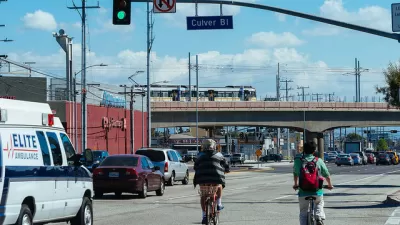Local leaders are challenging state-mandated affordable housing requirements for the 2021-2029 cycle.

In ongoing discussions in the city council, Santa Monica is deciding how to respond to the Southern California Association of Governments (SCAG)'s affordable housing requirement for the 2021-2029 cycle. Some local leaders argue that SCAG's mandate of 9,000 new affordable housing units is unrealistic and doesn't take into account local needs or funding availability, writes Brennon Dixson in the Santa Monica Daily Press.
The Housing Element, a mandatory element of Santa Monica’s General Plan, is "basically a housing needs assessment that features updated demographic data, data on housing stock, identifying barriers to the production of housing — both for market-rate and affordable housing," according to Santa Monica Planning Director Jing Yeo. Some members of the city council are balking at the new number, which doubles the requirement from the last cycle. "I understand that as much as we all espouse our love for affordable housing, we have to acknowledge there are people in our community who feel that the RHNA numbers are real lemons," said Councilmember Kevin McKeown, adding that funding the new affordable housing units, estimated at $3.5 to $5 billion, is a significant challenge.
Councilwoman Gleam Davis defended the state's affordable housing plan, calling it a "moral obligation" to the people who live and work in Santa Monica. "By providing more housing, we will actually be able to make people’s lives better," she said.
Other Southern California cities, including Pasadena and Beverly Hills, have challenged SCAG's decisions for the upcoming cycle, setting the stage for a delicate balancing act between local control and California's dire need for more housing.
FULL STORY: Housing Element discussions continue

Planetizen Federal Action Tracker
A weekly monitor of how Trump’s orders and actions are impacting planners and planning in America.

Maui's Vacation Rental Debate Turns Ugly
Verbal attacks, misinformation campaigns and fistfights plague a high-stakes debate to convert thousands of vacation rentals into long-term housing.

San Francisco Suspends Traffic Calming Amidst Record Deaths
Citing “a challenging fiscal landscape,” the city will cease the program on the heels of 42 traffic deaths, including 24 pedestrians.

Amtrak Rolls Out New Orleans to Alabama “Mardi Gras” Train
The new service will operate morning and evening departures between Mobile and New Orleans.

The Subversive Car-Free Guide to Trump's Great American Road Trip
Car-free ways to access Chicagoland’s best tourist attractions.

San Antonio and Austin are Fusing Into one Massive Megaregion
The region spanning the two central Texas cities is growing fast, posing challenges for local infrastructure and water supplies.
Urban Design for Planners 1: Software Tools
This six-course series explores essential urban design concepts using open source software and equips planners with the tools they need to participate fully in the urban design process.
Planning for Universal Design
Learn the tools for implementing Universal Design in planning regulations.
Heyer Gruel & Associates PA
JM Goldson LLC
Custer County Colorado
City of Camden Redevelopment Agency
City of Astoria
Transportation Research & Education Center (TREC) at Portland State University
Jefferson Parish Government
Camden Redevelopment Agency
City of Claremont





























